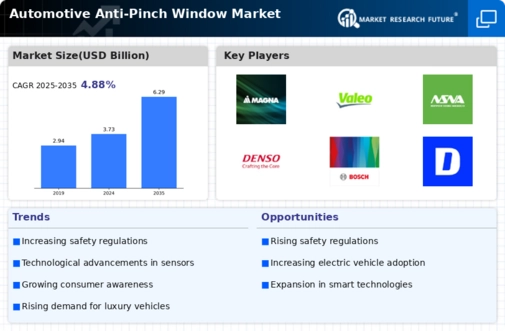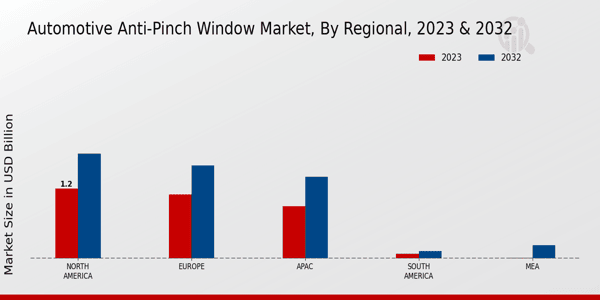Market Growth Projections
The Global Automotive Anti-Pinch Window Market Industry is projected to experience substantial growth in the coming years. With a market size of 3.73 USD Billion in 2024, it is expected to reach 6.29 USD Billion by 2035, reflecting a compound annual growth rate of 4.87% from 2025 to 2035. This growth trajectory indicates a robust demand for automotive safety features, driven by regulatory requirements, technological advancements, and consumer preferences. The increasing focus on vehicle safety and the integration of innovative technologies are likely to sustain this upward trend, positioning the anti-pinch window segment as a key area of development within the automotive industry.
Rise of Electric Vehicles
The rise of electric vehicles (EVs) is expected to have a profound impact on the Global Automotive Anti-Pinch Window Market Industry. As the automotive industry shifts towards electrification, manufacturers are incorporating advanced safety features, including anti-pinch windows, to enhance the overall user experience. EVs often come equipped with sophisticated electronic systems that can seamlessly integrate anti-pinch technology. This trend not only improves safety but also aligns with the growing consumer expectation for high-tech features in modern vehicles. The increasing adoption of EVs is likely to bolster the demand for anti-pinch windows, further driving market growth.
Increasing Vehicle Safety Regulations
The Global Automotive Anti-Pinch Window Market Industry is significantly influenced by the rise in stringent vehicle safety regulations across various regions. Governments are increasingly mandating safety features in vehicles to protect occupants, particularly children, from injuries caused by power windows. For instance, regulations in Europe and North America require anti-pinch mechanisms in new vehicle models. This regulatory push is expected to drive the market, as manufacturers seek to comply with these standards. As a result, the market is projected to reach 3.73 USD Billion in 2024, reflecting the growing emphasis on safety in automotive design.
Global Market Expansion and Emerging Economies
The Global Automotive Anti-Pinch Window Market Industry is poised for expansion, particularly in emerging economies where automotive ownership is on the rise. Countries such as India and Brazil are witnessing a surge in vehicle sales, leading to increased demand for safety features, including anti-pinch windows. As these markets develop, manufacturers are likely to focus on providing vehicles that meet international safety standards. This expansion into emerging markets presents a significant opportunity for growth, as local consumers become more aware of safety features and regulations. The overall market dynamics suggest a favorable environment for the proliferation of anti-pinch technology.
Consumer Awareness and Demand for Safety Features
Growing consumer awareness regarding vehicle safety is a significant driver for the Global Automotive Anti-Pinch Window Market Industry. As consumers become more informed about the potential dangers associated with power windows, they increasingly demand vehicles equipped with advanced safety features. This trend is particularly evident in family-oriented vehicles, where safety is a top priority. Manufacturers are responding to this demand by incorporating anti-pinch technology into their designs, thereby enhancing their market appeal. The projected market size of 6.29 USD Billion by 2035 underscores the importance of consumer preferences in shaping automotive safety features.
Technological Advancements in Automotive Features
Technological innovations play a pivotal role in shaping the Global Automotive Anti-Pinch Window Market Industry. The integration of advanced sensors and control systems in vehicles enhances the functionality of anti-pinch windows, making them more reliable and efficient. For example, the use of pressure sensors allows windows to detect obstructions and reverse automatically, thereby preventing injuries. As automotive technology continues to evolve, manufacturers are likely to invest in these advanced features, contributing to market growth. The anticipated compound annual growth rate of 4.87% from 2025 to 2035 indicates a robust demand for such innovations in the automotive sector.














